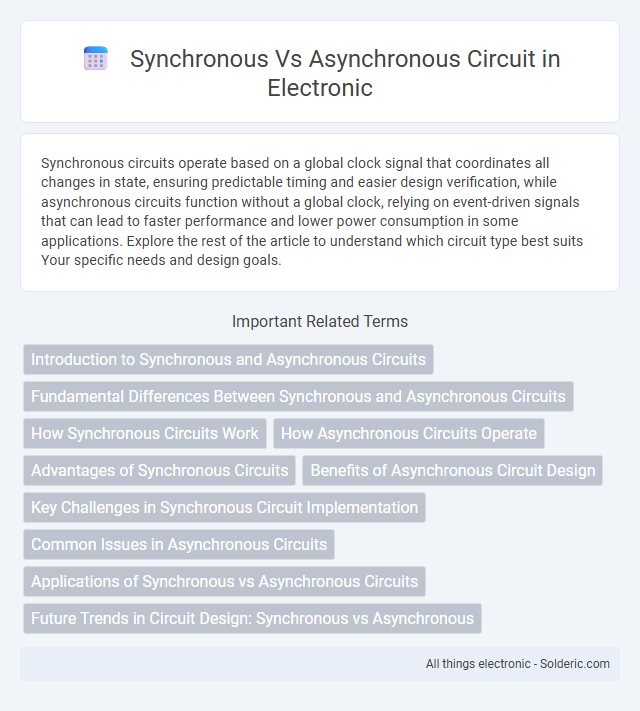Synchronous circuits operate based on a global clock signal that coordinates all changes in state, ensuring predictable timing and easier design verification, while asynchronous circuits function without a global clock, relying on event-driven signals that can lead to faster performance and lower power consumption in some applications. Explore the rest of the article to understand which circuit type best suits Your specific needs and design goals.
Comparison Table
| Feature | Synchronous Circuit | Asynchronous Circuit |
|---|---|---|
| Clock Dependency | Requires a global clock signal | No global clock; operates on event-driven signals |
| Speed | Limited by the clock frequency | Potentially faster due to no clock constraints |
| Design Complexity | Relatively simpler design and verification | More complex design and timing analysis |
| Power Consumption | Higher power due to clock switching | Lower power as circuits activate only on events |
| Noise and EMI | More electromagnetic interference (EMI) from clock | Less EMI, no periodic clock transitions |
| Use Cases | Common in CPUs, digital systems | Used in low-power, speed-critical applications |
Introduction to Synchronous and Asynchronous Circuits
Synchronous circuits operate based on a global clock signal, ensuring all components transition states simultaneously, which simplifies design and timing analysis. Asynchronous circuits, on the other hand, function without a global clock, relying on local handshaking signals to manage data flow, offering potential advantages in speed and power efficiency. Understanding these fundamental differences helps you choose the appropriate circuit type for optimizing performance and resource utilization in your electronic designs.
Fundamental Differences Between Synchronous and Asynchronous Circuits
Synchronous circuits operate based on a global clock signal that coordinates all operations, ensuring precise timing and predictable behavior. In contrast, asynchronous circuits function without a central clock, relying on handshaking signals and event-driven control, which can lead to lower power consumption and increased speed in certain applications. Your choice between these depends on design complexity, timing requirements, and power efficiency needs.
How Synchronous Circuits Work
Synchronous circuits operate based on a global clock signal that coordinates all internal components, ensuring changes in the circuit state occur simultaneously at clock edges. Flip-flops and registers store data, with transitions triggered precisely by the clock, enabling predictable timing and easier design verification. Your system's performance and reliability benefit from this synchronization, as timing constraints are well-defined and managed consistently across the entire circuit.
How Asynchronous Circuits Operate
Asynchronous circuits operate without a global clock, using handshaking protocols to manage data transfer between components, which allows them to respond immediately to input changes. They rely on local timing signals and completion detection to coordinate operations, reducing clock-related power consumption and electromagnetic interference. This event-driven approach enables asynchronous circuits to achieve higher speed, lower latency, and increased robustness in variable timing environments compared to synchronous designs.
Advantages of Synchronous Circuits
Synchronous circuits offer precise timing control by using a global clock signal, which simplifies the design and debugging processes. They provide reliable synchronization across all components, reducing the risk of race conditions and glitches. This predictability enhances performance in complex digital systems, making synchronous circuits ideal for applications requiring consistent timing and high-speed operation.
Benefits of Asynchronous Circuit Design
Asynchronous circuit design offers significant advantages, including reduced power consumption and lower electromagnetic interference due to the absence of a global clock signal. These circuits also provide enhanced speed performance since operations occur only when needed, allowing for more efficient use of resources and improved handling of variable data rates. Your electronic system can achieve higher robustness and scalability by leveraging the inherent flexibility of asynchronous designs in complex or noisy environments.
Key Challenges in Synchronous Circuit Implementation
Synchronous circuit implementation faces key challenges such as clock skew, which causes timing mismatches across components, and clock distribution complexity that escalates with increased circuit size. Setup and hold time violations further complicate reliable operation by demanding precise timing constraints to ensure data stability. Power consumption and electromagnetic interference from high-frequency clock signals also pose significant hurdles in scaling synchronous designs.
Common Issues in Asynchronous Circuits
Asynchronous circuits often face issues such as race conditions, glitches, and metastability, which arise from the lack of a global clock to coordinate signal changes. Delays in signal propagation can cause hazards and timing errors, making design and verification more complex compared to synchronous circuits. Careful timing analysis and robust design techniques are essential to mitigate these challenges and ensure reliable operation.
Applications of Synchronous vs Asynchronous Circuits
Synchronous circuits are widely used in digital processors, memory devices, and communication systems where precise timing and coordinated data transfer are critical for performance and reliability. Asynchronous circuits find applications in low-power devices, embedded systems, and environments with unpredictable timing, offering advantages in speed and energy efficiency by eliminating global clock signals. Both circuit types serve distinct roles in electronics, balancing trade-offs between synchronization, complexity, power consumption, and operational speed.
Future Trends in Circuit Design: Synchronous vs Asynchronous
Future trends in circuit design emphasize energy efficiency and speed, with asynchronous circuits gaining traction due to their lower power consumption and reduced electromagnetic interference compared to synchronous counterparts. Synchronous circuits continue to dominate in applications requiring precise timing and predictability, benefiting from mature design tools and established standards. Your choice between synchronous and asynchronous designs will depend on the specific trade-offs in performance, complexity, and power requirements for emerging technologies.
synchronous vs asynchronous circuit Infographic

 solderic.com
solderic.com